外研版(2019)选择性必修 第二册Unit 3 Times change! Developing ideas Reading 课件(共54张PPT)
文档属性
| 名称 | 外研版(2019)选择性必修 第二册Unit 3 Times change! Developing ideas Reading 课件(共54张PPT) |
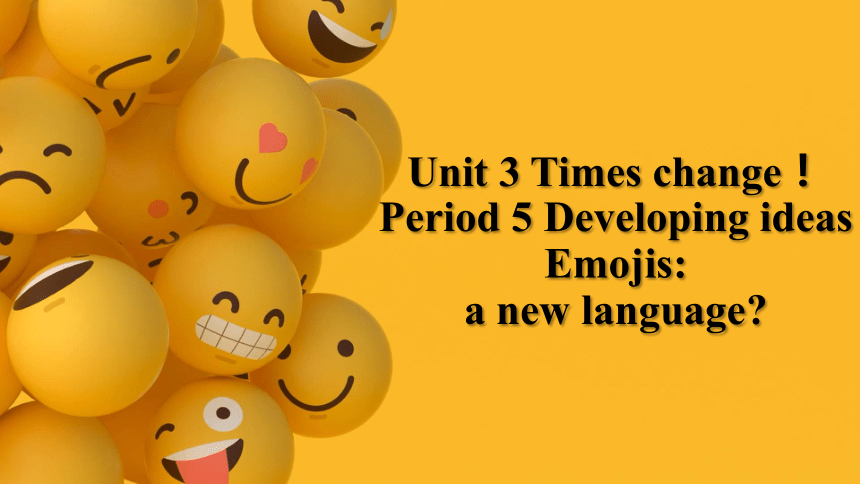
|
|
| 格式 | pptx | ||
| 文件大小 | 85.8MB | ||
| 资源类型 | 教案 | ||
| 版本资源 | 外研版(2019) | ||
| 科目 | 英语 | ||
| 更新时间 | 2024-10-19 15:43:49 | ||
图片预览

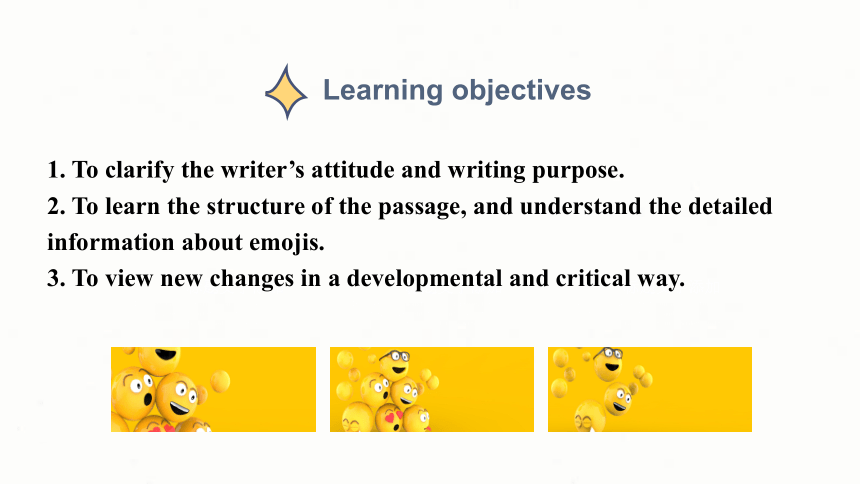
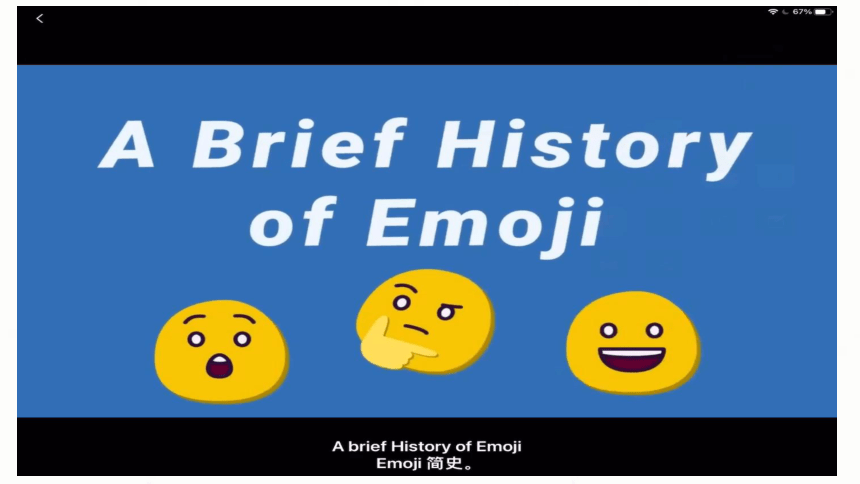
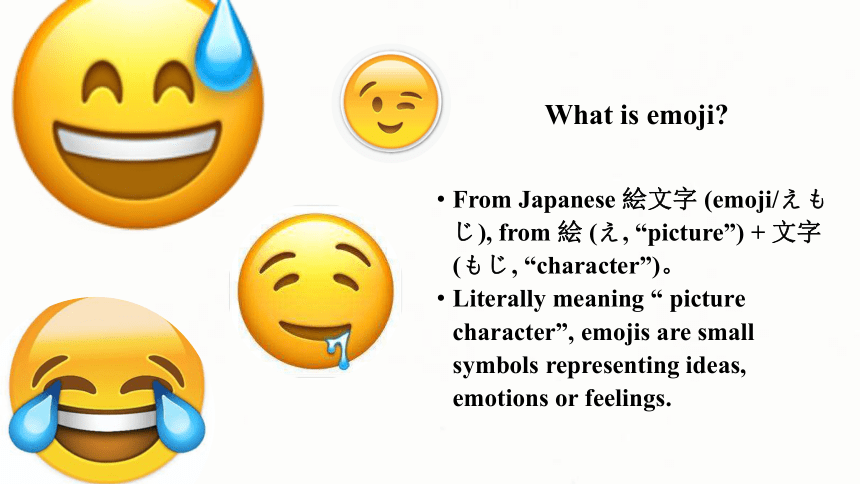
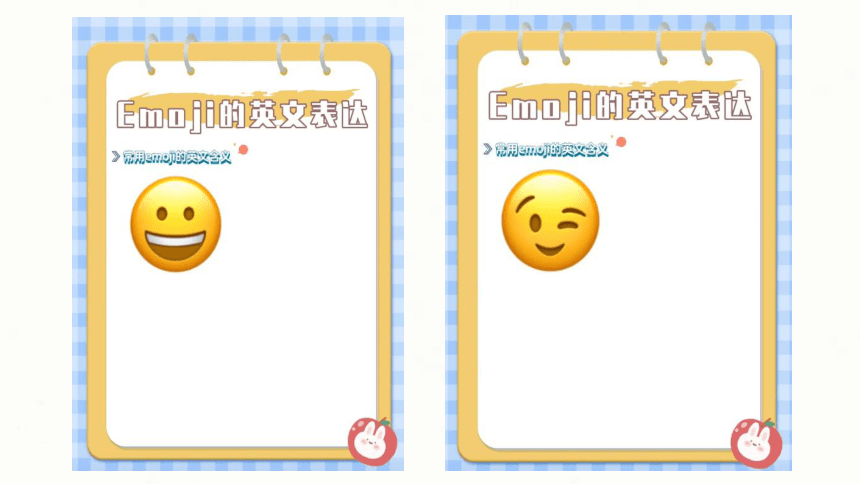
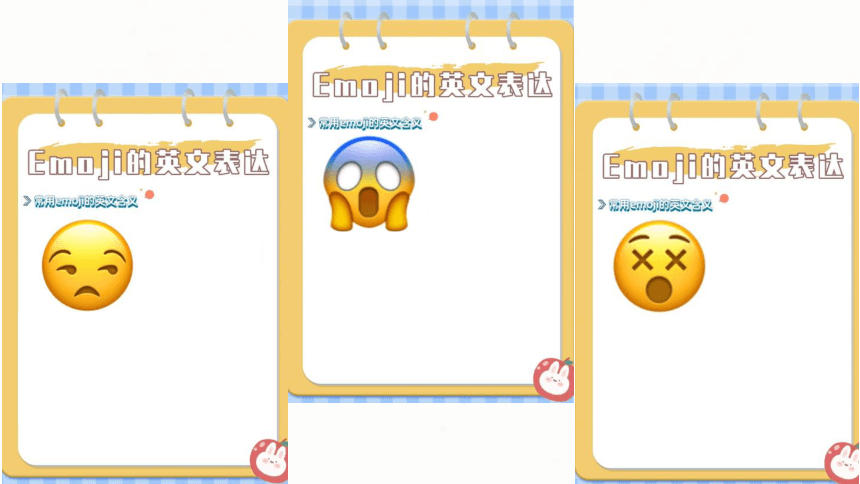

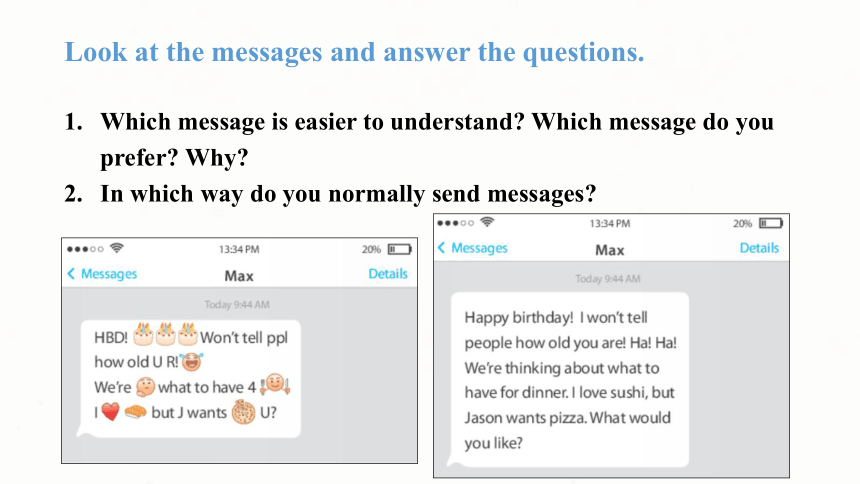
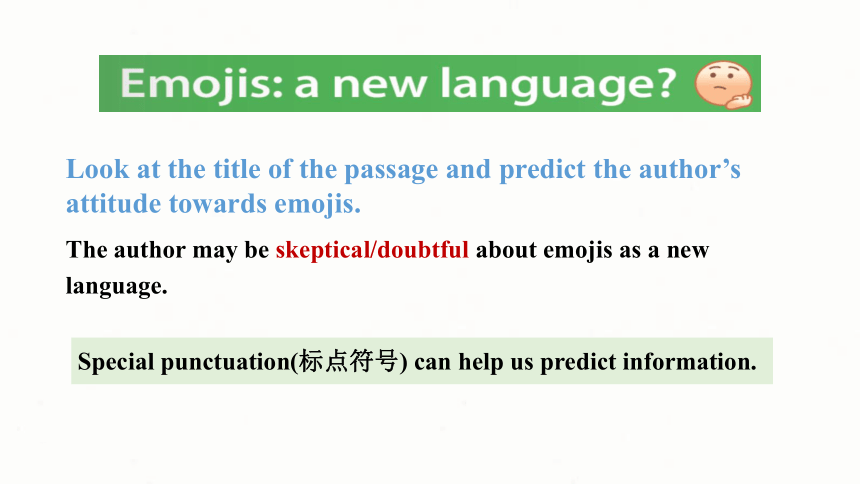
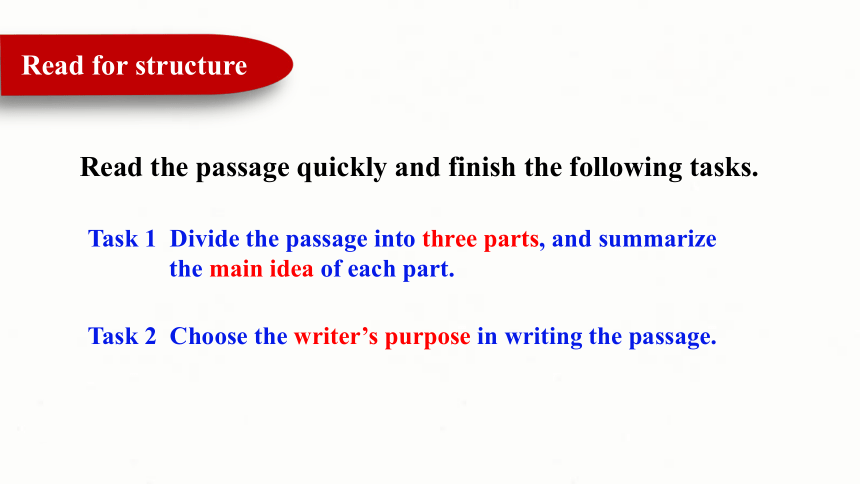
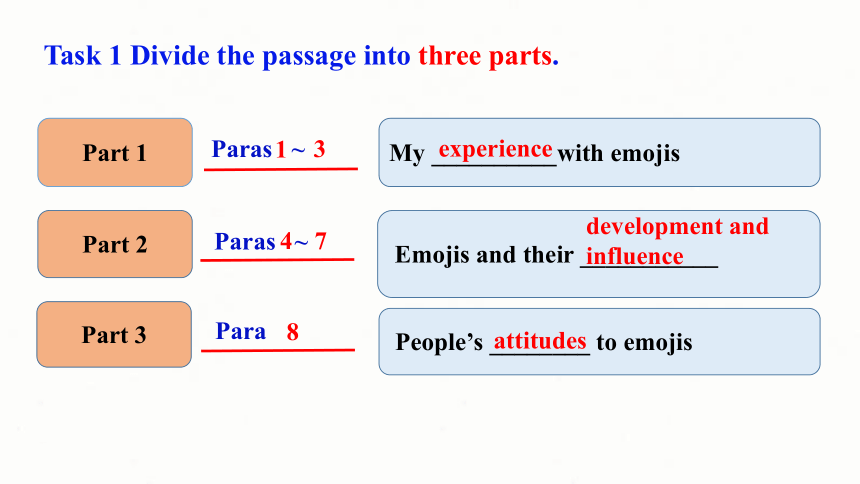
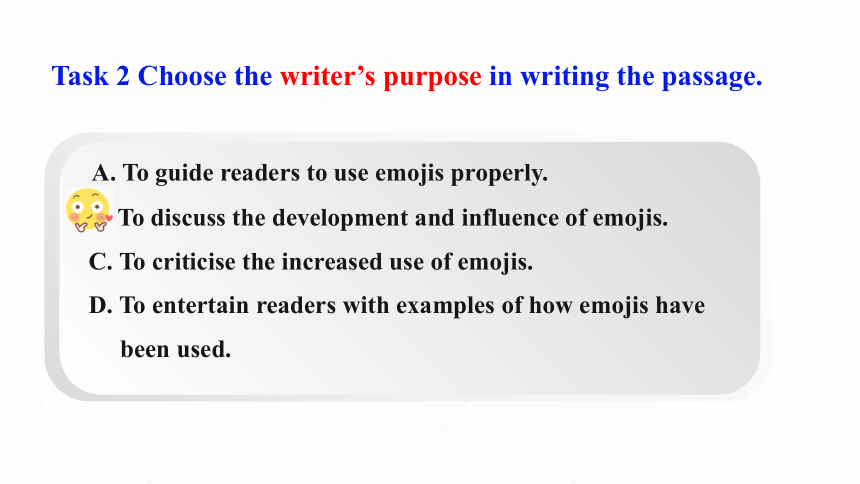
文档简介
(共54张PPT)
Unit 3 Times change!
Period 5 Developing ideas
Emojis:
a new language
标题文字添加
The user can demonstrate on a projector or computer, or presentation and make it film to be used in a wider field
标题文字添加
The user can demonstrate on a projector or computer, or presentation and make it film to be used in a wider field
标题文字添加
The user can demonstrate on a projector or computer, or presentation and make it film to be used in a wider field
1. To clarify the writer’s attitude and writing purpose.
2. To learn the structure of the passage, and understand the detailed information about emojis.
3. To view new changes in a developmental and critical way.
Learning objectives
What is emoji
From Japanese 絵文字 (emoji/えもじ), from 絵 (え, “picture”) + 文字 (もじ, “character”)。
Literally meaning “ picture character”, emojis are small symbols representing ideas, emotions or feelings.
Guess the idioms!
hot potato: a tricky problem
barking up the wrong tree: to follow a wrong course to achieve something intended (缘木求鱼)
once in a blue moon: very rarely
Look at the messages and answer the questions.
Which message is easier to understand Which message do you prefer Why
In which way do you normally send messages
Look at the title of the passage and predict the author’s attitude towards emojis.
The author may be skeptical/doubtful about emojis as a new language.
Special punctuation(标点符号) can help us predict information.
Read for structure
Read the passage quickly and finish the following tasks.
Task 1 Divide the passage into three parts, and summarize
the main idea of each part.
Task 2 Choose the writer’s purpose in writing the passage.
My __________with emojis
Emojis and their ___________
People’s ________ to emojis
Part 1
Part 3
Part 2
development and influence
Task 1 Divide the passage into three parts.
Paras ~
Paras ~
Para
experience
attitudes
1
3
8
7
4
Task 2 Choose the writer’s purpose in writing the passage.
A. To guide readers to use emojis properly.
B. To discuss the development and influence of emojis.
C. To criticise the increased use of emojis.
D. To entertain readers with examples of how emojis have
been used.
Read for details (Part 1)
1. What was the writer’s experience
2. Why did he mention his experience
3. Why didn’t he reply to his friend with the words “OK,
don’t rush”
He communicated with his friend through messages packed with emojis.
To introduce the topic of the passage.
Tip1: When you introduce a topic, you can mention your own experiences, a movie/book, and you can also use a quotation(引语).
Read for details (Part 1)
3. Why didn’t he reply to his friend with the words “OK,
don’t rush”
He attempted to follow the trend of communicating with emojis.
We should learn from the writer to
have an __________ to new things.
open mind
Read for details (Part 2)
1. What are emojis
2. How have emojis developed
Emojis are small symbols representing ideas, emotions or feelings, literally meaning “picture character”.
Origin
Japanese
More and more popular
Why
advantages
Why
add emotional meaning;
replace words
convenient;
more interested; technology & networks...
Classical literature
more accessible;
take away the
heart and soul of ...
more than 3000
Attitudes
In 1999, Japan
176
Shigetaka Kurita
(栗田穣崇)
2015 牛津词典年度词汇
quick and easy;
Emojis were used frequently, and they were officially approved.
Why
Think and share
1. Why does the writer mention the Shakespeare series with emojis
To show emojis are so popular that they have been used in the classics.
To show people’s concern about the essence(精华) being taken away, and losing the attraction of words.
Tip 2:
When you give your opinion, your argument will be stronger if it
is supported by examples/ evidence.
2. Do you think the Shakespeare series with emojis is an effective way to encourage young readers to read the classics
Useful expressions:
“我认为”: As far as I’m concerned, In my view/ opinion, From my point of view...
“不同意/担心”: I’m worried that, I’m afraid that, I’m concerned that...
Think and share
Internet emojis have been around for more than 20 years. Scott Fahlman, a professor of artificial intelligence at Carnegie Mellon University since 1982, uses the symbol ":-)" for jokes and ":-(" for problems to be taken seriously on university bulletin boards. In this way, Internet users can avoid misunderstandings arising from online communication. Since then, the Internet emoticons have been rapidly popularized and used.
网络表情符号的历史沿革网络表情符号已经有二十多年的历史。从1982 年被美国人卡耐基·梅隆大学研究人工智能的斯科特·法尔曼教授在大学的电子公告牌上用“:-)”这个符号表示笑话,用“:-(”表示需要严肃对待的问题。这样,网络使用者就能避免网上交流产生的误解。从此网络表情符号得到了迅速普及和使用。
Read for details (Part 3)
What are people’s attitudes to emojis
They facilitate the way ...
They worry that we are
losing the ability to ...
One day ... a real pictorial “language”.
For now ... just enjoy ...
positive
objective
negative
The writer
Users
Educators
Tip 3:
When evaluating something, you are supposed to judge it rationally(理性地) and objectively.
本文属于说明文。课文围绕“emojis”这一话题展开,介绍了表情符号的发展变化过程,让我们从全新的角度感受网络语言对表达方式的影响。
本文前两段以一个日常生活中使用emojis进行交流的真实场景为开篇,这种采用场景描述的方法使得作者的介绍生动形象,让读者感觉身临其境。
以数字对比和牛津字典为例,有力地证明了emojis的发展之快、使用之广
用具体原因和实例来说明emojis为什么越来越流行
用权威著作来举例说明emojis走进了古典文学。however前后表明人们对于改编古典文学时使用textspeak和emojis的不同看法,引人思考。
总结全文,并给出作者自己的观点。
Work in groups. Give a talk about the sentence from the passage.
1 Read the sentence and decide whether you agree or disagree with it.
2 Provide three reasons to support your ideas and give evidence for each reason. Make notes.
Perhaps people will one day choose to communicate in pictures, but forget how to write properly. What’s your opinion
Evidence:
Reasons:
When you give your opinion, your argument will be stronger if it is supported by evidence.Evidence can come from primary sources, such as original documents and interviews, or secondary sources, such as books and magazines
1. Emojis can lead to confusion.
2. Emojis can only express a very limited amount of meaning.
3. Emojis are not suitble for use in specific situation.
1. The emoji that illustrates two folded hands.
2. Writing allows us to communicate abstract concepts.
3. Interview.
Reasons
Evidence
Reasons
Evidence
1. Using emojis frequently.
2. Expressing feelings with emojis more simply and clearly.
3. Emojis are an international language.
1.Over 6 billion emojis are sent on a daily basis, with over 90% of the world’s online community making regular use of them.
2. Enriching text with facial expression.
3. They can be easily interpreted.
Language Points
表情符号:一门新语言
在自助餐厅外等待的时候,我收到了朋友发来的信息。
我花了一分钟才理解这条消息的意思,这些符号是想说他要迟到了,会尽快过来。我没有简单地回复“好,别着急。而是从手机上搜索了几个表达相同意思的表情符号:
Emojis: a new language
While waiting outside the cafeteria, I received the following message from my friend
It took me a minute before I realised what it meant. The signs he used were to say that he’d be running late and would be there soon. Instead of replying with a simple “OK, don’t rush”, I searched for emojis on my phone that would express the same Message:
Para. 1-2
这是我追随使用表情符号交流这一潮流的一次尝试。表情符号无处不在,从短信到电子邮件、博客以及其他社交媒体网络都会使用表情符号。随着社交媒体的飞速发展,表情符号正在成为我们用于表达自我的语言不可或缺的一部分。
This was my attempt to follow the trend of communicating with emojis. Emojis are used everywhere, from text messages to emails, blogs and other social media networks. With the rapid development of social media, emojis are becoming an integral component of the language we use to express ourselves.
Para. 3
一词源于日语,字面意思是“图画文字”。表情符号是表示想法、情绪或感受的小图标。它们可分为不同类别,比如面部表情和人物、动植物、食品饮料等。
The word "emoji” comes from Japanese, literally meaning picture character". Emojis are small symbols representing ideas emotions or feelings. They come in different categories, such as faces and people, plants and animals, and food and drink “ Emoji”
Para. 4
1. literally meaning “picture character”:
现在分词短语的伴随状语。它所表达的动作或状态是伴随着句子谓语的动作而发生或存在的。
Eg. Students went away, running and laughing.
The boy sat in front of the farmhouse, cutting the branch(树枝).
The word "emoji” comes from Japanese, literally meaning picture character". Emojis are small symbols representing ideas emotions or feelings. They come in different categories, such as faces and people, plants and animals, and food and drink “ Emoji”
Para. 4
1999年,表情符号首次在日本推出,当时只有176个简单的图案。但现在我们能使用3,000多个表情符号来拓宽我们的交流渠道。由于表情符号的风靡,牛津词典2015年的年度词汇是( ),这是图画文字首次替代了传统意义上的单词。
When first introduced in Japan in 1999, emojis were limited to 176 simple designs. Now there are more than 3, 000 emojis that expand upon the way in which we communicate. Due to their popularity, the Oxford Dictionaries Word of the Year in 2015 was for the first time ever, a pictograph instead of a traditional word.
Para. 5
1. be limited to... 局限于……(to 是介词)
limit...to... 把……限制在……内
go over a limit/go beyond a limit 超过限度
without limit 无限制地
within limits 在合理限度内
set a limit to/on 设定……的限度
When first introduced in Japan in 1999, emojis were limited to 176 simple designs. Now there are more than 3, 000 emojis that expand upon the way in which we communicate. Due to their popularity, the Oxford Dictionaries Word of the Year in 2015 was for the first time ever, a pictograph instead of a traditional word.
Para. 5
1. be limited to... 局限于……(to 是介词)
练习:
(1)Applicants are limited to ___________(apply)for one position.
(2) Some service may be limited ___________ registered members.
When first introduced in Japan in 1999, emojis were limited to 176 simple designs. Now there are more than 3, 000 emojis that expand upon the way in which we communicate. Due to their popularity, the Oxford Dictionaries Word of the Year in 2015 was for the first time ever, a pictograph instead of a traditional word.
Para. 5
applying
to
1. 此句中 introduced 是过去分词做状语,其逻辑主语是主句的主语emojis。
过去分词(短语)做状语可在分词前加某些连词。常用的有if、unless、when、once、until、though、as if等。此结构实际上是状语从句的省略形式,当状语从句的主语和主句的主语一致,且状语从句的谓语含有be动词的某种形式时,省略从句的主语和 be 动词。
When first introduced in Japan in 1999, emojis were limited to 176 simple designs. Now there are more than 3, 000 emojis that expand upon the way in which we communicate. Due to their popularity, the Oxford Dictionaries Word of the Year in 2015 was for the first time ever, a pictograph instead of a traditional word.
Para. 5
1. 此句中 introduced 是过去分词做状语,其逻辑主语是主句的主语emojis。
练习:
(1)When __________(ask) for his views about his teaching job, Philip said he found it rewarding and interesting.
(2)Children, when ____________(accompany)by their parents, are allowed to enter the stadium.
When first introduced in Japan in 1999, emojis were limited to 176 simple designs. Now there are more than 3, 000 emojis that expand upon the way in which we communicate. Due to their popularity, the Oxford Dictionaries Word of the Year in 2015 was for the first time ever, a pictograph instead of a traditional word.
Para. 5
asked
accompanied
在当今世界,表情符号越来越受欢迎。表情符号似乎比书面语言更具明显优势。人们喜欢它们,因为它们增添了语言的情感含义,使用方便快捷。事实上,这就像我们说话时用的手势一样。当在信息或帖子中加一个微笑表情或悲伤表情时,你的读者在读你写的内容时就能“看到”你的面部表情。
In today's world, emojis have become more and more popular. It seems that emojis have clear advantages over written language People like them because they add emotional meaning, and are quick and easy to use. In fact, this is similar to the gestures we use when we speak. With a smiling or sad face added to a message or post, your reader can"see "your facial expression while reading your words.
Para. 6
advantage n. [C] 优点;有利因素
Eg. His height gives him a clear advantage.
他的身高使他具有明显的优势。
take full advantage of 充分利用
have an advantage over 胜过;优于
advantages and disadvantages 利与弊
at a disadvantage 处于不利地位
competitive advantages 竞争优势
In today's world, emojis have become more and more popular. It seems that emojis have clear advantages over written language People like them because they add emotional meaning, and are quick and easy to use. In fact, this is similar to the gestures we use when we speak. With a smiling or sad face added to a message or post, your reader can"see "your facial expression while reading your words.
Para. 6
1. 在 “It seems that”举行中, It为形式主语,没有实际意义, that引导主语从句。
“It seems that” 可以转换成 “主语 + seem + to do”。例如,“Emojis seem to have clear advantages over written language.”
In today's world, emojis have become more and more popular. It seems that emojis have clear advantages over written language People like them because they add emotional meaning, and are quick and easy to use. In fact, this is similar to the gestures we use when we speak. With a smiling or sad face added to a message or post, your reader can"see "your facial expression while reading your words.
Para. 6
1. 在 “It seems that”举行中, It为形式主语,没有实际意义, that引导主语从句。
练习:
似乎没人知道公园里发生了什么。
____________ no one knows exactly what happened in the park.
No one __________________ exactly what happened in the park.
In today's world, emojis have become more and more popular. It seems that emojis have clear advantages over written language People like them because they add emotional meaning, and are quick and easy to use. In fact, this is similar to the gestures we use when we speak. With a smiling or sad face added to a message or post, your reader can"see "your facial expression while reading your words.
Para. 6
1. 在 “It seems that”举行中, It为形式主语,没有实际意义, that引导主语从句。
练习:
似乎没人知道公园里发生了什么。
____________ no one knows exactly what happened in the park.
No one __________________ exactly what happened in the park.
In today's world, emojis have become more and more popular. It seems that emojis have clear advantages over written language People like them because they add emotional meaning, and are quick and easy to use. In fact, this is similar to the gestures we use when we speak. With a smiling or sad face added to a message or post, your reader can"see "your facial expression while reading your words.
Para. 6
It seems that
seems to know
1. with sth. done 结构在句中作状语,a smiling or sad face与 add 之间是被动关系,所以 add 用过去分词形式。
翻译:
(1)关机后你可以进入教室。
(2)作业写完之后,她去购物了。
In today's world, emojis have become more and more popular. It seems that emojis have clear advantages over written language People like them because they add emotional meaning, and are quick and easy to use. In fact, this is similar to the gestures we use when we speak. With a smiling or sad face added to a message or post, your reader can"see "your facial expression while reading your words.
Para. 6
1. with sth. done 结构在句中作状语,a smiling or sad face与 add 之间是被动关系,所以 add 用过去分词形式。
翻译:
(1)关机后你可以进入教室。
(2)作业写完之后,她去购物了。
In today's world, emojis have become more and more popular. It seems that emojis have clear advantages over written language People like them because they add emotional meaning, and are quick and easy to use. In fact, this is similar to the gestures we use when we speak. With a smiling or sad face added to a message or post, your reader can"see "your facial expression while reading your words.
Para. 6
You can enter the room with your phone powered off.
With the homework finished, she went shopping.
表情符号还能帮助人们在找不到合适的词汇时表达他们的感受。举个例子,假如你的朋友将要搬去另一个国家,你可以发给他们一串哭脸,来表达自己对于你们将要分离的忧伤之情。
Emojis can also help people express their feelings when they cannot find the appropriate words. For instance. if your friend is moving across the country. you may just send them a string of crying faces to express your sadness over your separation.
Para. 6
表情符号的使用甚至蔓延到经典文学之中。一套为年轻读者写的、内容取材于威廉 莎士比亚流行戏剧的系列丛书,就把书中一些词语更換为短信简写语和表情符号。这些改写的目的是为了使经典著作更容易被年轻读者接受。然而,也有人认为这些新版本剥夺了莎士比亚戏剧的精髓。
The use of emojis has even spread to classical literature. A Shakespeare series for young readers has taken William Shakespeare's popular plays and replaced some words with textspeak and emojis. The intention of these adaptations is to make the classics more accessible to young readers. Some people, however, believe that these new versions have taken away the heart and soul of Shakespeare's plays.
Para. 7
正如我们所见,表情符号的趋势是变得越来越随处可见。表情符号的使用者声称它们更便于我沟通交流、表达自我。但是这使得一些人,尤其是教育工作者,担心我们正在失去使用书面语甚至语来正确沟通的能力。
As we can see, emojis have a tendency to pop up all over the place. Users of emojis say that they facilitate the way in which we communicate and express ourselves. But this makes others especially educators, worry that we are losing the ability to communicate properly using the written word, or even the spoken word.
Para. 8
1. tendency n. [C] 趋势
have a tendency to do sth. 有做某事的倾向
tend v. 倾向于;照顾
tend to / towards 趋向 / 倾向于
tend to sb / sth 照料,照看某人 / 某事
tend to do sth 易于 / 往往会做某事
As we can see, emojis have a tendency to pop up all over the place. Users of emojis say that they facilitate the way in which we communicate and express ourselves. But this makes others especially educators, worry that we are losing the ability to communicate properly using the written word, or even the spoken word.
Para. 8
1. as 在此句中引导非限定性定语从句,as引导非限定性定语从句的时候,在句中做主语或宾语。as引导此类句子可以放在句首、句中和句尾。常见的搭配有:
as we know 众所周知
as is reported 正如报道的
as is mentioned 正如所提到的那样
as is shown 正如所示
As we can see, emojis have a tendency to pop up all over the place. Users of emojis say that they facilitate the way in which we communicate and express ourselves. But this makes others especially educators, worry that we are losing the ability to communicate properly using the written word, or even the spoken word.
Para. 8
1. as 在此句中引导非限定性定语从句,as引导非限定性定语从句的时候,在句中做主语或宾语。as引导此类句子可以放在句首、句中和句尾。
练习:
(1)________ is often the case, girls like dolls while boys like guns.
(2)She and her family bicycle(v.) to work, _______ helps them keep fit.
As we can see, emojis have a tendency to pop up all over the place. Users of emojis say that they facilitate the way in which we communicate and express ourselves. But this makes others especially educators, worry that we are losing the ability to communicate properly using the written word, or even the spoken word.
Para. 8
As
which
that 引导的从句作 worry 的宾语,其中不定式 “to communicate” 作名词 ability 的后置定语;
As we can see, emojis have a tendency to pop up all over the place. Users of emojis say that they facilitate the way in which we communicate and express ourselves. But this makes others especially educators, worry that we are losing the ability to communicate properly using the written word, or even the spoken word.
Para. 8
“using the written word, or even the spoken word” 为现在分词短语作方式状语。
As we can see, emojis have a tendency to pop up all over the place. Users of emojis say that they facilitate the way in which we communicate and express ourselves. But this makes others especially educators, worry that we are losing the ability to communicate properly using the written word, or even the spoken word.
Para. 8
毕竟,现如今,我们当中有多少人宁愿发送一条满是表情符号的短信,也不愿意打电话 或许有一天,人们会选择用图片来交流,忘记怎样正确书写。到那一天,表情符号将成为真正的图画“语言”。但是现在,或许我们最好还是享受使用它们的乐趣吧!
After all, how many of us today would rather send a message packed with emojis than make a telephone call Perhaps people will one day choose to communicate in pictures and forget how to write properly. On that day, emojis will have become a real pictorial "language". But, for now, maybe it's best that we just enjoy using them.
Para. 8
a message packed with emojis 中 packed with emojis 作后置定语修饰前面的 a message,意为“一条都是表情符号的信息。”
After all, how many of us today would rather send a message packed with emojis than make a telephone call Perhaps people will one day choose to communicate in pictures and forget how to write properly. On that day, emojis will have become a real pictorial "language". But, for now, maybe it's best that we just enjoy using them.
Para. 8
would rather do ... than do ... 结构,意为 “宁愿做 …… 而不愿做 ……”。
After all, how many of us today would rather send a message packed with emojis than make a telephone call Perhaps people will one day choose to communicate in pictures and forget how to write properly. On that day, emojis will have become a real pictorial "language". But, for now, maybe it's best that we just enjoy using them.
Para. 8
Unit 3 Times change!
Period 5 Developing ideas
Emojis:
a new language
标题文字添加
The user can demonstrate on a projector or computer, or presentation and make it film to be used in a wider field
标题文字添加
The user can demonstrate on a projector or computer, or presentation and make it film to be used in a wider field
标题文字添加
The user can demonstrate on a projector or computer, or presentation and make it film to be used in a wider field
1. To clarify the writer’s attitude and writing purpose.
2. To learn the structure of the passage, and understand the detailed information about emojis.
3. To view new changes in a developmental and critical way.
Learning objectives
What is emoji
From Japanese 絵文字 (emoji/えもじ), from 絵 (え, “picture”) + 文字 (もじ, “character”)。
Literally meaning “ picture character”, emojis are small symbols representing ideas, emotions or feelings.
Guess the idioms!
hot potato: a tricky problem
barking up the wrong tree: to follow a wrong course to achieve something intended (缘木求鱼)
once in a blue moon: very rarely
Look at the messages and answer the questions.
Which message is easier to understand Which message do you prefer Why
In which way do you normally send messages
Look at the title of the passage and predict the author’s attitude towards emojis.
The author may be skeptical/doubtful about emojis as a new language.
Special punctuation(标点符号) can help us predict information.
Read for structure
Read the passage quickly and finish the following tasks.
Task 1 Divide the passage into three parts, and summarize
the main idea of each part.
Task 2 Choose the writer’s purpose in writing the passage.
My __________with emojis
Emojis and their ___________
People’s ________ to emojis
Part 1
Part 3
Part 2
development and influence
Task 1 Divide the passage into three parts.
Paras ~
Paras ~
Para
experience
attitudes
1
3
8
7
4
Task 2 Choose the writer’s purpose in writing the passage.
A. To guide readers to use emojis properly.
B. To discuss the development and influence of emojis.
C. To criticise the increased use of emojis.
D. To entertain readers with examples of how emojis have
been used.
Read for details (Part 1)
1. What was the writer’s experience
2. Why did he mention his experience
3. Why didn’t he reply to his friend with the words “OK,
don’t rush”
He communicated with his friend through messages packed with emojis.
To introduce the topic of the passage.
Tip1: When you introduce a topic, you can mention your own experiences, a movie/book, and you can also use a quotation(引语).
Read for details (Part 1)
3. Why didn’t he reply to his friend with the words “OK,
don’t rush”
He attempted to follow the trend of communicating with emojis.
We should learn from the writer to
have an __________ to new things.
open mind
Read for details (Part 2)
1. What are emojis
2. How have emojis developed
Emojis are small symbols representing ideas, emotions or feelings, literally meaning “picture character”.
Origin
Japanese
More and more popular
Why
advantages
Why
add emotional meaning;
replace words
convenient;
more interested; technology & networks...
Classical literature
more accessible;
take away the
heart and soul of ...
more than 3000
Attitudes
In 1999, Japan
176
Shigetaka Kurita
(栗田穣崇)
2015 牛津词典年度词汇
quick and easy;
Emojis were used frequently, and they were officially approved.
Why
Think and share
1. Why does the writer mention the Shakespeare series with emojis
To show emojis are so popular that they have been used in the classics.
To show people’s concern about the essence(精华) being taken away, and losing the attraction of words.
Tip 2:
When you give your opinion, your argument will be stronger if it
is supported by examples/ evidence.
2. Do you think the Shakespeare series with emojis is an effective way to encourage young readers to read the classics
Useful expressions:
“我认为”: As far as I’m concerned, In my view/ opinion, From my point of view...
“不同意/担心”: I’m worried that, I’m afraid that, I’m concerned that...
Think and share
Internet emojis have been around for more than 20 years. Scott Fahlman, a professor of artificial intelligence at Carnegie Mellon University since 1982, uses the symbol ":-)" for jokes and ":-(" for problems to be taken seriously on university bulletin boards. In this way, Internet users can avoid misunderstandings arising from online communication. Since then, the Internet emoticons have been rapidly popularized and used.
网络表情符号的历史沿革网络表情符号已经有二十多年的历史。从1982 年被美国人卡耐基·梅隆大学研究人工智能的斯科特·法尔曼教授在大学的电子公告牌上用“:-)”这个符号表示笑话,用“:-(”表示需要严肃对待的问题。这样,网络使用者就能避免网上交流产生的误解。从此网络表情符号得到了迅速普及和使用。
Read for details (Part 3)
What are people’s attitudes to emojis
They facilitate the way ...
They worry that we are
losing the ability to ...
One day ... a real pictorial “language”.
For now ... just enjoy ...
positive
objective
negative
The writer
Users
Educators
Tip 3:
When evaluating something, you are supposed to judge it rationally(理性地) and objectively.
本文属于说明文。课文围绕“emojis”这一话题展开,介绍了表情符号的发展变化过程,让我们从全新的角度感受网络语言对表达方式的影响。
本文前两段以一个日常生活中使用emojis进行交流的真实场景为开篇,这种采用场景描述的方法使得作者的介绍生动形象,让读者感觉身临其境。
以数字对比和牛津字典为例,有力地证明了emojis的发展之快、使用之广
用具体原因和实例来说明emojis为什么越来越流行
用权威著作来举例说明emojis走进了古典文学。however前后表明人们对于改编古典文学时使用textspeak和emojis的不同看法,引人思考。
总结全文,并给出作者自己的观点。
Work in groups. Give a talk about the sentence from the passage.
1 Read the sentence and decide whether you agree or disagree with it.
2 Provide three reasons to support your ideas and give evidence for each reason. Make notes.
Perhaps people will one day choose to communicate in pictures, but forget how to write properly. What’s your opinion
Evidence:
Reasons:
When you give your opinion, your argument will be stronger if it is supported by evidence.Evidence can come from primary sources, such as original documents and interviews, or secondary sources, such as books and magazines
1. Emojis can lead to confusion.
2. Emojis can only express a very limited amount of meaning.
3. Emojis are not suitble for use in specific situation.
1. The emoji that illustrates two folded hands.
2. Writing allows us to communicate abstract concepts.
3. Interview.
Reasons
Evidence
Reasons
Evidence
1. Using emojis frequently.
2. Expressing feelings with emojis more simply and clearly.
3. Emojis are an international language.
1.Over 6 billion emojis are sent on a daily basis, with over 90% of the world’s online community making regular use of them.
2. Enriching text with facial expression.
3. They can be easily interpreted.
Language Points
表情符号:一门新语言
在自助餐厅外等待的时候,我收到了朋友发来的信息。
我花了一分钟才理解这条消息的意思,这些符号是想说他要迟到了,会尽快过来。我没有简单地回复“好,别着急。而是从手机上搜索了几个表达相同意思的表情符号:
Emojis: a new language
While waiting outside the cafeteria, I received the following message from my friend
It took me a minute before I realised what it meant. The signs he used were to say that he’d be running late and would be there soon. Instead of replying with a simple “OK, don’t rush”, I searched for emojis on my phone that would express the same Message:
Para. 1-2
这是我追随使用表情符号交流这一潮流的一次尝试。表情符号无处不在,从短信到电子邮件、博客以及其他社交媒体网络都会使用表情符号。随着社交媒体的飞速发展,表情符号正在成为我们用于表达自我的语言不可或缺的一部分。
This was my attempt to follow the trend of communicating with emojis. Emojis are used everywhere, from text messages to emails, blogs and other social media networks. With the rapid development of social media, emojis are becoming an integral component of the language we use to express ourselves.
Para. 3
一词源于日语,字面意思是“图画文字”。表情符号是表示想法、情绪或感受的小图标。它们可分为不同类别,比如面部表情和人物、动植物、食品饮料等。
The word "emoji” comes from Japanese, literally meaning picture character". Emojis are small symbols representing ideas emotions or feelings. They come in different categories, such as faces and people, plants and animals, and food and drink “ Emoji”
Para. 4
1. literally meaning “picture character”:
现在分词短语的伴随状语。它所表达的动作或状态是伴随着句子谓语的动作而发生或存在的。
Eg. Students went away, running and laughing.
The boy sat in front of the farmhouse, cutting the branch(树枝).
The word "emoji” comes from Japanese, literally meaning picture character". Emojis are small symbols representing ideas emotions or feelings. They come in different categories, such as faces and people, plants and animals, and food and drink “ Emoji”
Para. 4
1999年,表情符号首次在日本推出,当时只有176个简单的图案。但现在我们能使用3,000多个表情符号来拓宽我们的交流渠道。由于表情符号的风靡,牛津词典2015年的年度词汇是( ),这是图画文字首次替代了传统意义上的单词。
When first introduced in Japan in 1999, emojis were limited to 176 simple designs. Now there are more than 3, 000 emojis that expand upon the way in which we communicate. Due to their popularity, the Oxford Dictionaries Word of the Year in 2015 was for the first time ever, a pictograph instead of a traditional word.
Para. 5
1. be limited to... 局限于……(to 是介词)
limit...to... 把……限制在……内
go over a limit/go beyond a limit 超过限度
without limit 无限制地
within limits 在合理限度内
set a limit to/on 设定……的限度
When first introduced in Japan in 1999, emojis were limited to 176 simple designs. Now there are more than 3, 000 emojis that expand upon the way in which we communicate. Due to their popularity, the Oxford Dictionaries Word of the Year in 2015 was for the first time ever, a pictograph instead of a traditional word.
Para. 5
1. be limited to... 局限于……(to 是介词)
练习:
(1)Applicants are limited to ___________(apply)for one position.
(2) Some service may be limited ___________ registered members.
When first introduced in Japan in 1999, emojis were limited to 176 simple designs. Now there are more than 3, 000 emojis that expand upon the way in which we communicate. Due to their popularity, the Oxford Dictionaries Word of the Year in 2015 was for the first time ever, a pictograph instead of a traditional word.
Para. 5
applying
to
1. 此句中 introduced 是过去分词做状语,其逻辑主语是主句的主语emojis。
过去分词(短语)做状语可在分词前加某些连词。常用的有if、unless、when、once、until、though、as if等。此结构实际上是状语从句的省略形式,当状语从句的主语和主句的主语一致,且状语从句的谓语含有be动词的某种形式时,省略从句的主语和 be 动词。
When first introduced in Japan in 1999, emojis were limited to 176 simple designs. Now there are more than 3, 000 emojis that expand upon the way in which we communicate. Due to their popularity, the Oxford Dictionaries Word of the Year in 2015 was for the first time ever, a pictograph instead of a traditional word.
Para. 5
1. 此句中 introduced 是过去分词做状语,其逻辑主语是主句的主语emojis。
练习:
(1)When __________(ask) for his views about his teaching job, Philip said he found it rewarding and interesting.
(2)Children, when ____________(accompany)by their parents, are allowed to enter the stadium.
When first introduced in Japan in 1999, emojis were limited to 176 simple designs. Now there are more than 3, 000 emojis that expand upon the way in which we communicate. Due to their popularity, the Oxford Dictionaries Word of the Year in 2015 was for the first time ever, a pictograph instead of a traditional word.
Para. 5
asked
accompanied
在当今世界,表情符号越来越受欢迎。表情符号似乎比书面语言更具明显优势。人们喜欢它们,因为它们增添了语言的情感含义,使用方便快捷。事实上,这就像我们说话时用的手势一样。当在信息或帖子中加一个微笑表情或悲伤表情时,你的读者在读你写的内容时就能“看到”你的面部表情。
In today's world, emojis have become more and more popular. It seems that emojis have clear advantages over written language People like them because they add emotional meaning, and are quick and easy to use. In fact, this is similar to the gestures we use when we speak. With a smiling or sad face added to a message or post, your reader can"see "your facial expression while reading your words.
Para. 6
advantage n. [C] 优点;有利因素
Eg. His height gives him a clear advantage.
他的身高使他具有明显的优势。
take full advantage of 充分利用
have an advantage over 胜过;优于
advantages and disadvantages 利与弊
at a disadvantage 处于不利地位
competitive advantages 竞争优势
In today's world, emojis have become more and more popular. It seems that emojis have clear advantages over written language People like them because they add emotional meaning, and are quick and easy to use. In fact, this is similar to the gestures we use when we speak. With a smiling or sad face added to a message or post, your reader can"see "your facial expression while reading your words.
Para. 6
1. 在 “It seems that”举行中, It为形式主语,没有实际意义, that引导主语从句。
“It seems that” 可以转换成 “主语 + seem + to do”。例如,“Emojis seem to have clear advantages over written language.”
In today's world, emojis have become more and more popular. It seems that emojis have clear advantages over written language People like them because they add emotional meaning, and are quick and easy to use. In fact, this is similar to the gestures we use when we speak. With a smiling or sad face added to a message or post, your reader can"see "your facial expression while reading your words.
Para. 6
1. 在 “It seems that”举行中, It为形式主语,没有实际意义, that引导主语从句。
练习:
似乎没人知道公园里发生了什么。
____________ no one knows exactly what happened in the park.
No one __________________ exactly what happened in the park.
In today's world, emojis have become more and more popular. It seems that emojis have clear advantages over written language People like them because they add emotional meaning, and are quick and easy to use. In fact, this is similar to the gestures we use when we speak. With a smiling or sad face added to a message or post, your reader can"see "your facial expression while reading your words.
Para. 6
1. 在 “It seems that”举行中, It为形式主语,没有实际意义, that引导主语从句。
练习:
似乎没人知道公园里发生了什么。
____________ no one knows exactly what happened in the park.
No one __________________ exactly what happened in the park.
In today's world, emojis have become more and more popular. It seems that emojis have clear advantages over written language People like them because they add emotional meaning, and are quick and easy to use. In fact, this is similar to the gestures we use when we speak. With a smiling or sad face added to a message or post, your reader can"see "your facial expression while reading your words.
Para. 6
It seems that
seems to know
1. with sth. done 结构在句中作状语,a smiling or sad face与 add 之间是被动关系,所以 add 用过去分词形式。
翻译:
(1)关机后你可以进入教室。
(2)作业写完之后,她去购物了。
In today's world, emojis have become more and more popular. It seems that emojis have clear advantages over written language People like them because they add emotional meaning, and are quick and easy to use. In fact, this is similar to the gestures we use when we speak. With a smiling or sad face added to a message or post, your reader can"see "your facial expression while reading your words.
Para. 6
1. with sth. done 结构在句中作状语,a smiling or sad face与 add 之间是被动关系,所以 add 用过去分词形式。
翻译:
(1)关机后你可以进入教室。
(2)作业写完之后,她去购物了。
In today's world, emojis have become more and more popular. It seems that emojis have clear advantages over written language People like them because they add emotional meaning, and are quick and easy to use. In fact, this is similar to the gestures we use when we speak. With a smiling or sad face added to a message or post, your reader can"see "your facial expression while reading your words.
Para. 6
You can enter the room with your phone powered off.
With the homework finished, she went shopping.
表情符号还能帮助人们在找不到合适的词汇时表达他们的感受。举个例子,假如你的朋友将要搬去另一个国家,你可以发给他们一串哭脸,来表达自己对于你们将要分离的忧伤之情。
Emojis can also help people express their feelings when they cannot find the appropriate words. For instance. if your friend is moving across the country. you may just send them a string of crying faces to express your sadness over your separation.
Para. 6
表情符号的使用甚至蔓延到经典文学之中。一套为年轻读者写的、内容取材于威廉 莎士比亚流行戏剧的系列丛书,就把书中一些词语更換为短信简写语和表情符号。这些改写的目的是为了使经典著作更容易被年轻读者接受。然而,也有人认为这些新版本剥夺了莎士比亚戏剧的精髓。
The use of emojis has even spread to classical literature. A Shakespeare series for young readers has taken William Shakespeare's popular plays and replaced some words with textspeak and emojis. The intention of these adaptations is to make the classics more accessible to young readers. Some people, however, believe that these new versions have taken away the heart and soul of Shakespeare's plays.
Para. 7
正如我们所见,表情符号的趋势是变得越来越随处可见。表情符号的使用者声称它们更便于我沟通交流、表达自我。但是这使得一些人,尤其是教育工作者,担心我们正在失去使用书面语甚至语来正确沟通的能力。
As we can see, emojis have a tendency to pop up all over the place. Users of emojis say that they facilitate the way in which we communicate and express ourselves. But this makes others especially educators, worry that we are losing the ability to communicate properly using the written word, or even the spoken word.
Para. 8
1. tendency n. [C] 趋势
have a tendency to do sth. 有做某事的倾向
tend v. 倾向于;照顾
tend to / towards 趋向 / 倾向于
tend to sb / sth 照料,照看某人 / 某事
tend to do sth 易于 / 往往会做某事
As we can see, emojis have a tendency to pop up all over the place. Users of emojis say that they facilitate the way in which we communicate and express ourselves. But this makes others especially educators, worry that we are losing the ability to communicate properly using the written word, or even the spoken word.
Para. 8
1. as 在此句中引导非限定性定语从句,as引导非限定性定语从句的时候,在句中做主语或宾语。as引导此类句子可以放在句首、句中和句尾。常见的搭配有:
as we know 众所周知
as is reported 正如报道的
as is mentioned 正如所提到的那样
as is shown 正如所示
As we can see, emojis have a tendency to pop up all over the place. Users of emojis say that they facilitate the way in which we communicate and express ourselves. But this makes others especially educators, worry that we are losing the ability to communicate properly using the written word, or even the spoken word.
Para. 8
1. as 在此句中引导非限定性定语从句,as引导非限定性定语从句的时候,在句中做主语或宾语。as引导此类句子可以放在句首、句中和句尾。
练习:
(1)________ is often the case, girls like dolls while boys like guns.
(2)She and her family bicycle(v.) to work, _______ helps them keep fit.
As we can see, emojis have a tendency to pop up all over the place. Users of emojis say that they facilitate the way in which we communicate and express ourselves. But this makes others especially educators, worry that we are losing the ability to communicate properly using the written word, or even the spoken word.
Para. 8
As
which
that 引导的从句作 worry 的宾语,其中不定式 “to communicate” 作名词 ability 的后置定语;
As we can see, emojis have a tendency to pop up all over the place. Users of emojis say that they facilitate the way in which we communicate and express ourselves. But this makes others especially educators, worry that we are losing the ability to communicate properly using the written word, or even the spoken word.
Para. 8
“using the written word, or even the spoken word” 为现在分词短语作方式状语。
As we can see, emojis have a tendency to pop up all over the place. Users of emojis say that they facilitate the way in which we communicate and express ourselves. But this makes others especially educators, worry that we are losing the ability to communicate properly using the written word, or even the spoken word.
Para. 8
毕竟,现如今,我们当中有多少人宁愿发送一条满是表情符号的短信,也不愿意打电话 或许有一天,人们会选择用图片来交流,忘记怎样正确书写。到那一天,表情符号将成为真正的图画“语言”。但是现在,或许我们最好还是享受使用它们的乐趣吧!
After all, how many of us today would rather send a message packed with emojis than make a telephone call Perhaps people will one day choose to communicate in pictures and forget how to write properly. On that day, emojis will have become a real pictorial "language". But, for now, maybe it's best that we just enjoy using them.
Para. 8
a message packed with emojis 中 packed with emojis 作后置定语修饰前面的 a message,意为“一条都是表情符号的信息。”
After all, how many of us today would rather send a message packed with emojis than make a telephone call Perhaps people will one day choose to communicate in pictures and forget how to write properly. On that day, emojis will have become a real pictorial "language". But, for now, maybe it's best that we just enjoy using them.
Para. 8
would rather do ... than do ... 结构,意为 “宁愿做 …… 而不愿做 ……”。
After all, how many of us today would rather send a message packed with emojis than make a telephone call Perhaps people will one day choose to communicate in pictures and forget how to write properly. On that day, emojis will have become a real pictorial "language". But, for now, maybe it's best that we just enjoy using them.
Para. 8
